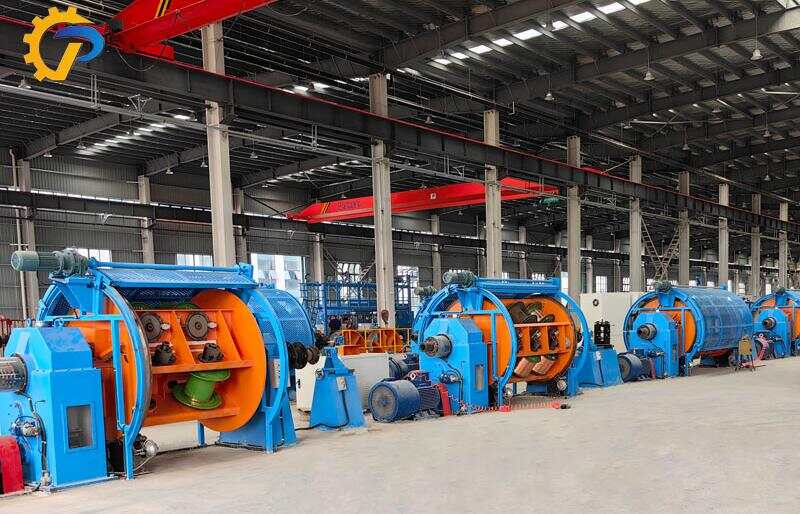Email format error
Email cannot be empty
Email already exists
6-20 characters(letters plus numbers only)
The password is inconsistent
Email format error
Email cannot be empty
Email does not exist
6-20 characters(letters plus numbers only)
The password is inconsistent


How to Choose the Right Cable Stranding Machine for Your Factory
Selecting the right cable stranding machine is a critical decision for any wire and cable manufacturing facility. The right machine boosts productivity, enhances cable quality, and reduces long-term costs. But with so many options available, how do you choose the right cable stranding machine that fits your specific production needs?
In this guide, we'll walk you through the most important considerations, machine types, and technical factors to help you make a well-informed investment.
What Is a Cable Stranding Machine?
A cable stranding machine is specialized equipment used in the wire and cable industry to twist individual wires into a single cohesive strand. This process improves the flexibility, strength, and electrical performance of cables. Depending on the cable type, stranding machines vary in configuration, size, and speed.
Common applications include:
-
Power cables (low, medium, and high voltage)
-
Communication cables (LAN, coaxial, fiber optic)
-
Control and instrumentation cables
Why Choosing the Right Cable Stranding Machine Matters
Selecting the wrong machine can result in:
-
Increased downtime
-
Low product quality
-
Excessive operational costs
-
Wasted materials
The right cable stranding machine enhances productivity, maintains consistent quality, and reduces maintenance over time. That's why the selection process should be based on careful consideration of your production requirements.
Key Factors to Consider When Choosing a Cable Stranding Machine
1. Cable Type and Product Specification
The first step is to define what kind of cables you'll be producing:
-
Flexible vs. rigid conductors
-
Solid core vs. multi-core cables
-
Size and material (e.g., copper, aluminum)
Different stranding machines are designed for specific types of cables:
-
Planetary Stranding Machines – Ideal for large cross-section power cables.
-
Tubular Stranding Machines – Best for round, solid conductors.
-
Rigid Frame Stranding Machines – Suitable for high-speed production of symmetrical cables.
2. Production Capacity and Speed Requirements
Evaluate your expected output volume:
-
Daily or monthly production targets
-
Required line speed (measured in RPM or meters per minute)
-
Integration with upstream or downstream equipment (e.g., pay-offs, take-ups, taping machines)
Choose a machine that not only meets current needs but also allows room for future scaling.
3. Level of Automation
Modern stranding machines come with varying degrees of automation:
-
Manual – Lower cost, but labor-intensive.
-
Semi-automatic – A balance between cost and efficiency.
-
Fully automatic – Offers the highest efficiency, consistency, and reduced labor costs.
Automation can also include:
-
Automatic tension control
-
Fault detection and alarm systems
-
Programmable touch-screen interfaces (HMI)
4. Quality of the Stranding Process
Check the machine's capability for:
-
Precision pitch control
-
Uniform lay length
-
Concentricity
These directly affect the mechanical and electrical properties of the final cable.
High-quality machines ensure minimal product rejection and excellent repeatability.
5. Machine Footprint and Layout
Consider your factory's space constraints. Some stranding machines—especially rigid frame types—require significant floor space and structural support. Make sure to:
-
Review the machine's layout drawing
-
Plan for maintenance access
-
Check for compatibility with your existing cable line setup
6. Reliability and After-Sales Support
Even the best machine is only as good as the service behind it. Evaluate the manufacturer’s:
-
After-sales service
-
Spare parts availability
-
Warranty terms
-
Remote troubleshooting support
For example, at Guangdong Chipeng, we provide full OEM/ODM solutions, technical support, and customization services tailored to your production needs.
Common Types of Cable Stranding Machines
Here's a quick breakdown of common machine types and their use cases:
| Machine Type | Application | Advantages |
| Rigid Frame Strander | Power, control, and sector-shaped cables | High speed, high tension capacity |
| Planetary Strander | Communication and control cables | Gentle stranding, core rotation |
| Tubular Strander | Round solid conductors, copper/aluminum cables | Balanced operation, suitable for medium speeds |
| Bow-type Laying-up Machine | Multi-core cable assembly | Good flexibility, efficient assembly |
Cost vs. Value: Making a Smart Investment
While price is always a factor, it's vital to assess the total cost of ownership. A cheaper machine may save money upfront but cost more in:
-
Downtime
-
Repairs
-
Energy inefficiency
-
Quality control issues
Investing in a high-quality cable stranding machine can boost profitability in the long run through improved product quality and lower maintenance costs.
Final Checklist Before Purchasing
-
Identify the types and specifications of cables you produce.
-
Match production speed with your business needs.
-
Choose the right type of stranding machine (rigid, tubular, planetary).
-
Evaluate the machine's automation and control features.
-
Consider factory layout and space availability.
-
Partner with a reliable manufacturer with strong support services.
Need Expert Help Choosing a Cable Stranding Machine?
As a professional wire and cable machine manufacturer, Guangdong Chipeng offers a wide range of stranding equipment customized to your exact specifications. From R&D to after-sales service, we support our clients every step of the way.
Contact us today to learn more or request a consultation.

